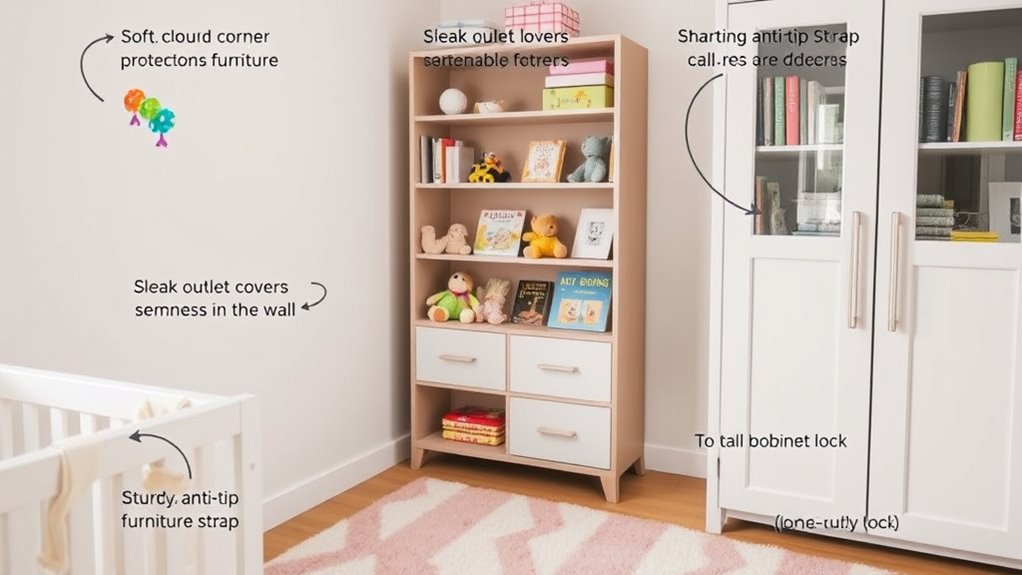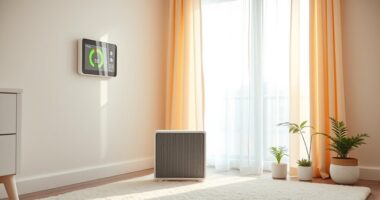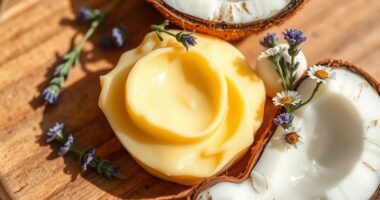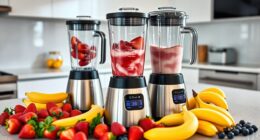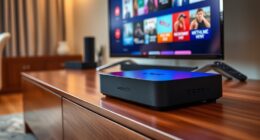To keep your home safe for your little one, invest in essential baby proofing products like wall anchors for furniture, outlet covers, safety gates for stairs, and cabinet locks to prevent access to hazardous items. Non-slip mats and corner protectors help reduce falls and injuries, while bathroom locks keep harmful substances out of reach. By implementing these must-haves, you’ll create a secure space where your child can explore confidently. Keep exploring to discover more helpful safety tips and products.
Key Takeaways
- Anchor heavy furniture and appliances to walls to prevent tipping and falls.
- Install outlet covers, safety locks, and cabinet latches to block access to hazards.
- Use safety gates, corner protectors, and non-slip mats to prevent falls and injuries.
- Secure windows with guards or stops to prevent accidental falls from heights.
- Keep small objects, batteries, and choking hazards out of reach to ensure a safe environment.
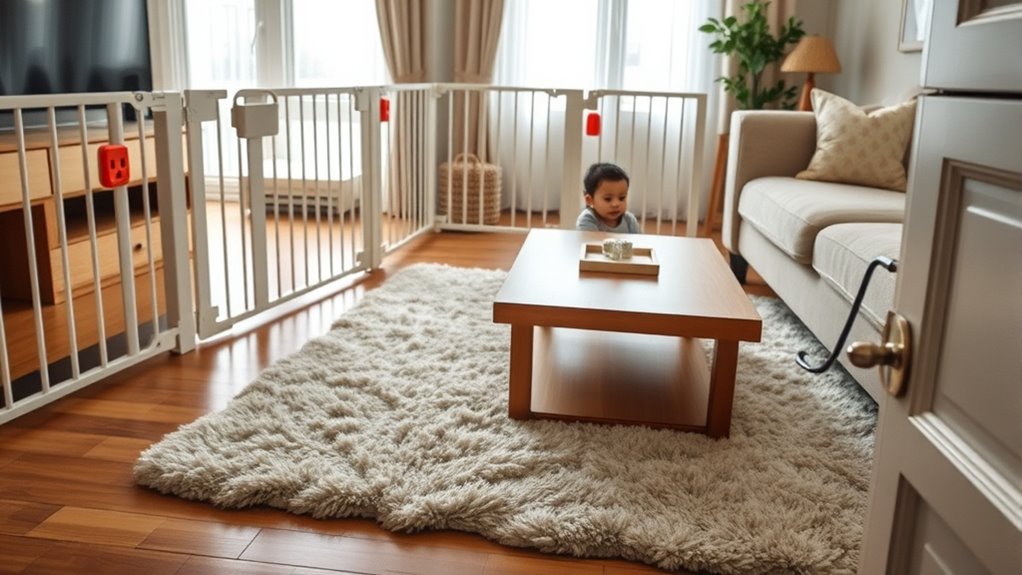
Are you prepared to keep your little one safe as they explore their surroundings? Creating a secure environment starts with prioritizing nursery safety and equipping your home with the right childproofing gadgets. Babies are naturally curious, and their desire to explore can lead to dangerous situations if your home isn’t properly prepared. That’s why investing in essential baby proofing products is a smart move to protect your child and give yourself peace of mind.
Ensuring nursery safety with the right childproofing gadgets keeps your little explorer safe and gives you peace of mind.
First, focus on securing furniture and heavy objects that could tip over. Anchor dressers, bookshelves, and TVs to the wall to prevent accidents. Use safety straps and brackets designed specifically for nursery safety. These gadgets are simple to install but highly effective in avoiding tragic injuries. Cover electrical outlets with outlet covers or safety plugs to prevent your little one from sticking fingers or objects into sockets. These small childproofing gadgets are inexpensive and easy to install, yet they offer significant protection.
Next, consider safeguarding windows and doorways. Use window guards or stops to prevent windows from opening wide enough for a child to fall out. Door finger guards can prevent little fingers from getting pinched or slammed. Installing safety locks on cabinets and drawers keeps curious hands from accessing sharp utensils, cleaning supplies, or other hazardous items. These childproofing gadgets are designed to be discreet and easy to use, ensuring that safety doesn’t compromise convenience.
In addition, baby-proof your home’s floors and stairs. Use safety gates at the top and bottom of stairs to prevent falls. Ensure that rugs are non-slip or secure them with rug pads to avoid tripping hazards. Keep choking hazards like small toys, coins, and batteries out of reach, and consider installing corner protectors on sharp furniture edges to prevent injuries during inevitable tumbles. These measures are critical components of nursery safety, helping to minimize risks as your child learns to navigate their environment.
Lastly, don’t forget about bathroom safety. Use toilet locks and cabinet latches to keep harmful substances out of reach. Consider a non-slip bath mat to prevent slipping during bath time. Childproofing gadgets like these are crucial in creating a safe space where your child can play, learn, and grow without constant supervision. Incorporating baby-proofing products that are specifically designed for nursery safety can further enhance your home’s protection.
Every nursery safety measure you take—whether it’s installing childproofing gadgets, securing furniture, or adding safety locks—adds an extra layer of protection. It might seem overwhelming at first, but tackling one area at a time makes it manageable. Remember, the goal is to create a home where your baby can explore freely and safely, giving you confidence as they grow and discover their world.
Frequently Asked Questions
How Do I Choose the Right Baby Proofing Products for My Home?
To choose the right baby proofing products, prioritize child safety and product durability. Assess your home’s specific hazards and select products that securely address those areas, like cabinet locks or outlet covers. Look for high-quality, durable materials to guarantee longevity. Read reviews to gauge effectiveness and safety standards. By focusing on durability and safety, you create a secure environment where your little one can explore confidently without unnecessary risks.
Are There Eco-Friendly Baby Proofing Options Available?
Are eco-friendly baby proofing options truly available? Absolutely. You can find products made from natural materials and biodegradable options that keep your little one safe without harming the environment. Think about safety gates, corner protectors, or outlet covers crafted from sustainable, non-toxic materials. These choices help create a safer, greener home and teach your child early on about caring for the planet. Why not choose products that protect both your baby and the Earth?
How Often Should I Replace Baby Proofing Devices?
You should replace baby proofing devices based on durability testing and replacement frequency recommendations. Check labels or manufacturer guidelines regularly, especially if the devices show signs of wear, damage, or looseness. Typically, you might need to substitute safety covers or locks every one to two years, but always prioritize safety over timing. Frequent inspections ensure your home remains secure as your baby grows and becomes more mobile.
Can Baby Proofing Products Be Used Temporarily?
Yes, you can definitely use baby proofing products temporarily. Sometimes, temporary safety measures are necessary, especially during visits or when your little one is exploring new areas. Removable baby proofing options let you quickly secure or remove devices without damage. Just remember to check them regularly, verify they’re secure, and remove them when no longer needed to keep your home safe and adaptable as your child’s needs change.
Are There Safety Certifications I Should Look For?
Yes, you should look for safety certifications on baby proofing products. Check for safety standards and certification labels like JPMA, ASTM, or UL, which guarantee the products meet rigorous safety requirements. These labels give you confidence that the items are tested and safe for your baby. Always verify these certifications before purchasing or installing baby proofing gear to ensure your home remains a safe environment for your little one.
Conclusion
With these baby-proofing products, you create a fortress of safety, turning your home into a gentle haven where your little explorer can grow and discover with confidence. Think of these tools as the sturdy walls and soft cushions that catch every stumble and protect every step. As you lay down these safety measures, you’re building a cozy, secure garden where your baby’s curiosity blooms freely, knowing their world is wrapped in love and protection.
